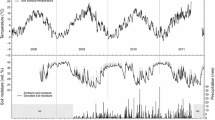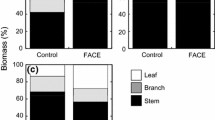Abstract
Physiological responses to elevated CO2 at the leaf and canopy-level were studied in an intact pine (Pinus taeda) forest ecosystem exposed to elevated CO2 using a free-air CO2 enrichment (FACE) technique. Normalized canopy water-use of trees exposed to elevated CO2 over an 8-day exposure period was similar to that of trees exposed to current ambient CO2 under sunny conditions. During a portion of the exposure period when sky conditions were cloudy, CO2-exposed trees showed minor (≤7%) but significant reductions in relative sap flux density compared to trees under ambient CO2 conditions. Short-term (minutes) direct stomatal responses to elevated CO2 were also relatively weak (≈5% reduction in stomatal aperture in response to high CO2 concentrations). We observed no evidence of adjustment in stomatal conductance in foliage grown under elevated CO2 for nearly 80 days compared to foliage grown under current ambient CO2, so intrinsic leaf water-use efficiency at elevated CO2 was enhanced primarily by direct responses of photosynthesis to CO2. We did not detect statistical differences in parameters from photosynthetic responses to intercellular CO2 (A net-C i curves) for Pinus taeda foliage grown under elevated CO2 (550 μmol mol−1) for 50–80 days compared to those for foliage grown under current ambient CO2 from similar-sized reference trees nearby. In both cases, leaf net photosynthetic rate at 550 μmol mol−1 CO2 was enhanced by approximately 65% compared to the rate at ambient CO2 (350 μmol mol−1). A similar level of enhancement under elevated CO2 was observed for daily photosynthesis under field conditions on a sunny day. While enhancement of photosynthesis by elevated CO2 during the study period appears to be primarily attributable to direct photosynthetic responses to CO2 in the pine forest, longer-term CO2 responses and feedbacks remain to be evaluated.
Similar content being viewed by others
References
Bacastow RB, Keeling CD, Whorf TP (1985) Seasonal amplitude increase in atmospheric CO2 concentration at Mauna Loa, Hawaii 1959–1982. J Geophys Res 90: 10 529–10 540
Bazzaz FA (1990) The response of natural ecosystems to the rising global CO2 levels. Annu Rev Ecol Syst 21: 167–196
Bunce J (1992) Stomatal conductance, photosynthesis and respiration of temperate deciduous tree seedlings grown outdoors at an elevated concentration of carbon dioxide. Plant Cell Environ 15: 541–549
Caemmerer S von, Farquhar GD (1981) Some relationships between the biochemistry of photosynthesis and the gas exchange of leaves. Planta 153: 376–387
Conroy JP, Kuppers M, Kuppers BIL, Virgona J, Barlow EWR (1988) The influence of CO2 enrichment, phosphorus deficiency and water stress on the growth, conductance and water use of Pinus radiata. Plant Cell Environ 11: 91–98
Dixon RK, Brown S, Houghton RA, Solomon AM, Trexler MC, Wisniewski J (1994) Carbon pools and flux of global forest ecosystems. Science 263: 185–190
Eamus D (1991) The interaction of rising CO2 and temperatures with water use efficiency. Plant Cell Environ 14: 843–852
Eamus D, Jarvis PG (1989) The direct effects of increase in the global atmospheric CO2 concentration on natural and commercial temperate trees and forests. Adv Ecol Res 19: 1–55
Ellsworth DS, Liu X (1994) Photosynthesis and canopy nutrition of four sugar maple forests on acid soils in northern Vermont. Can J For Res 24: 2118–2127
Farquhar GD, Caemmerer S von (1982) Modelling of photosynthetic response to environmental conditions. In: Lange OL, Nobel PS, Osmond CB, Ziegler H (eds) Encyclopedia of plant physiology (new series vol. 12B). Springer, Berlin Heidelberg New York, pp 546–587
Granier A (1987) Evaluation of transpiration in a Douglas-fir stand by means of sap flow measurements. Tree Physiol 3: 309–320
Grulke NE, Miller PR (1994) Changes in gas exchange characteristics during the life span of giant sequioa: implications for response to current and future concentrations of atmospheric ozone. Tree Physiol 14: 659–668
Gunderson CA, Wullschleger SD (1994) Photosynthetic acclimation in trees to rising CO2: a broader perspective. Photosynth Res 39: 369–388
Hanson PJ, Samuelson LJ, Wullschleger SD, Tabberer TA, Edwards GS (1994) Seasonal patterns of light-saturated photosynthesis and leaf conductance for mature and seedling Quercus rubra L. foliage: differential sensitivity to ozone exposure. Tree Physiol 14: 1351–1366
Harley PC, Thomas RB, Reynolds JF, Strain BR (1992) Modelling photosynthesis of cotton grown in elevated CO2. Plant Cell Environ 15: 271–282
Hendrey GR, Lewin KF, NagyJ (1993) Free air carbon dioxide enrichment: development, progress, results. Vegetatio 104/105: 17–31
Higginbotham KO (1974) The influence of canopy position and age of leaf tissue on growth and photosynthesis in loblolly pine. Ph.D. dissertation, Botany Department, Duke University, Durham, N.C., USA.
Hollinger DY (1987) Gas exchange and dry matter allocation responses to elevation of atmospheric CO2 concentration in seedlings of three species. Tree Physiol 3: 193–202
Jackson RB, Sala OE, Field CB, Mooney HA (1994) CO2 alters water use, carbon gain, and yield for the dominant species in a natural grassland. Oecologia 98: 257–262
Johnson JD (1984) A rapid technique for estimating total surface area of pine needles. For Sci 30: 913–921
Jones HG (1985) Partitioning stomatal and non-stomatal limitations to photosynthesis. Plant Cell Environ 8: 95–104
Kaushal P, Guehl JM, Aussenac G (1989) Differential growth response to atmospheric carbon dioxide enrichment in seedlings of Cedrus atlantica and Pinus nigra ssp. laricio var. Corsicana. Can J For Res 19: 1351–1358
Lewin KF, Hendrey GR, Nagy J, LaMorte R (1994) Design and application of a free-air carbon dioxide enrichment facility. Agric For Meteorol 70: 15–29
Mansfield TA, Hetherington AM, Atkinson CJ (1990) Some current aspects of stomatal physiology. Annu Rev Plant Physiol Plant Mol Biol 41: 55–75
Morison JIL (1987) Intercellular CO2 concentration and stomatal responses to CO2. In: Zeiger E, Farquhar GD, Cowan IR (eds) Stomatal function. Stanford University Press, pp 229–251
Mott KA (1988) Do stomata respond to CO2 concentrations other than intercellular. Plant Physiol 86: 200–203
Mousseau M, Saugier B (1992) The direct effect of increased CO2 on gas exchange and growth of forest tree species. J Exp Bot 43: 1121–1130
Norby RJ, O'Neill EG (1991) Leaf area compensation and nutrient interactions in CO2-enriched seedlings of yellow-poplar (Liriodendron tulipifera L.). New Phytol 117: 515–528
Norby RJ, Gunderson CA, Wullschleger SD, O'Neill EG, McCracken MK (1992) Productivity and compensatory responses of yellow-poplar trees in elevated CO2. Nature 357: 322–324
Oren R, Huang C, Phillips N, Pataki D, Christensen NL, Zimmermann R, Hendrey GR (1993) Water-use of managed southern pine and natural hardwood forests: scaling ground-based measurements to the ecosystem level (Southeastern Regional Center, National Institute for Global Environmental Change, 1993 Annual Report). University of Alabama, Tuscaloosa, pp 55–59
Overdieck D, Forstreuter M (1994) Evapotranspiration of beech stands and transpiration of beech leaves subject to atmospheric CO2 enrichment. Tree Physiol 14: 997–1003
Stitt M (1991) Rising CO2 levels and their potential significance for carbon flow in photosynthetic cells. Plant Cell Environ 14: 741–762
Surano KA, Daley PF, Houpis JLJ, Shinn JH, Helms JA, Palassou RJ, Costella MP (1986) Growth and physiological responses of Pinus ponderosa Dougl. ex P. Laws to long-term elevated CO2 concentrations. Tree Physiol 2: 243–259
Tans PP, Fung IY, Takahashi T (1990) Observational constraints on the global atmospheric CO2 budget. Science 247: 1431–1438
Tissue DT, Oechel WC (1987) Response of Eriophorum vaginatum to elevated CO2 and temperature in the Alaskan tussock tundra. Ecology 68: 401–441
Tolley LC, Strain BR (1985) Effects of CO2 enrichment and water stress on gas exchange of Liquidambar styraciflua and Pinus taeda seedlings grown under different irradiance levels. Oecologia 65: 166–172
Trabalka JR, Edwards JA, Reilly JM, Gardner RH, Reichle DE (1986) Atmospheric CO2 projection with globally averaged carbon cycle models. In: Trabalka JR, Reichle DE (eds) The changing carbon cycle: a global analysis. Springer, Berlin Heidelberg New York, pp 534–560
Watson RT, Rodhe H, Oeschger H, Siegenthaler U (1990) Greenhouse gases and aerosols. In: Houghton JT, Jenkins GJ, Ephraums JJ (eds) Climate change: the IPCC scientific assessment. Cambridge University Press, Cambridge, pp 1–40
Whitehead D, Teskey RO (1995) Dynamic response of stomata to changing irradiance in loblolly pine (Pinus taeda L.). Tree Physiology 15: 245–252
Woodward FI, Thompson GB, McKee IF (1991) The effects of elevated concentrations of carbon dioxide on individual plants, populations, communities and ecosystems. Ann Bot 67: 23–38
Wong SC, Dunin FX (1987) Photosynthesis and transpiration of trees in a eucalypt forest stand: CO2, light and humidity responses. Aust J Plant Physiol 14: 619–632
Author information
Authors and Affiliations
Rights and permissions
About this article
Cite this article
Ellsworth, D.S., Oren, R., Huang, C. et al. Leaf and canopy responses to elevated CO2 in a pine forest under free-air CO2 enrichment. Oecologia 104, 139–146 (1995). https://doi.org/10.1007/BF00328578
Received:
Accepted:
Issue Date:
DOI: https://doi.org/10.1007/BF00328578




